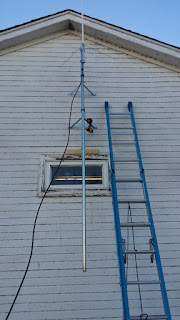Well, I managed to find the studs. My probing drillbit was too short to get all the way through the siding and into the studs. They are on standard 16" centers, obviating the need for the plywood!
With the brackets firmly into studs with 4" lag screws, I set about the delicate task of raising the antenna. My coax is a 50 foot run of LM400 with N connectors on either end. I secured an N to UHF adapter on the antenna, attached the coax and wrapped it with silicone self-fusing tape. I then assembled the antenna to the mast and leaned the nearly 20' tall assembly against the building within reach from the ladder.
Pulling the assembly up after me from the top of the ladder was easy enough, especially with most of the weight being in the bottom half. With the outer clamp bolts removed, the mast sort of snapped into place in the clamps. With the weight supported by the antenna mount resting on the upper bracket, I was able to put bolts in the clamps, which was enough to ensure that the mast could not fall out.
With the bottom bracket clamped just tight enough, I was able to put the mast up and trust friction to hold it in place while I gripped again lower. At this point, I was pretty excited that it was in the air and thus I forgot to tape the coax to the mast every foot or two as intended.
However, it is up!
My own climbing limitations kept me from getting it another 3 feet higher, but at this point, I don't really care :)
I routed the coax into the workshop and connected it to the IC-706mkIIg where the shimmer dulled a bit. The radio was acting up. It seemed to receive fine but when transmitting, the power output meter would rapidly peak then drop nearly to zero. Long story short, after dinking with it for about an hour, I was Googling for similar stories and I tried it again but now it worked perfectly. Thus far, it continues to work perfectly. Argh. Though it started working, I kind of suspect that there may be a cold solder joint in the radio. Receive works fine, but it breaks down under power, driving SWR up and the radio drops the power to save itself.
While I was troubleshooting, I pulled the old Kenwood TM-731 out and connected it. It worked great with all the Fort Worth repeaters in it's memory, so that pointed to a good antenna. Also, my ID-51 was able to hit a LOT of DFW Metroplex repeaters, particularly those in the northern reaches like Keller, Grapevine, Corinth and west to Weatherford, Azle, Aledo, etc. I was even able to hit the Azle repeater with the power set to minimum, which is 100mW. I don't know if I would really be audible at that power, but I was able to kerchunk it.
So, other than some iffy concerns with the '706, I'd say my antenna is UP!


No comments:
Post a Comment